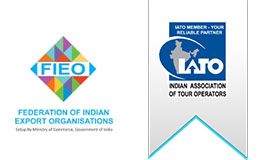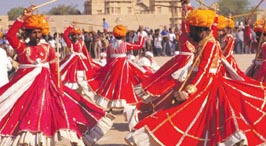
Rajasthan, home of the valiant Rajputs known for their bravery and chivalry, is aptly known as the “Land of Kings”. Situated in the North-west part of India, mostly comprising The Thar Desert also called “The Great Indian Desert”, and one of the oldest mountain range “The Aravalis”, Rajasthan holds the distinction of being the largest state in the Republic of India.
Imposing Forts, mesmerizing Palaces and magnificent Havelis, spread over the princely state of Rajasthan, remind us of rich history of this eternal land, and are one of the major attractions of the state as well as our country. A journey through these masterpieces makes visitors come back again and again to enjoy the majestic blend of royal past and modern comforts. Built on high hilltops, most of these forts and palaces have been marked as heritage sites, while some have been restored and converted into heritage hotels like the Raj Vilas (Jaipur), Udai Vilas (Udaipur) and Umaid Bhawan Palace (Jodhpur).
Rajasthan is culturally rich and has artistic and cultural traditions which reflect the ancient Indian way of life. Fairs and Festivals form an integral part of Rajasthani Culture, Traditions and Heritage, with an unending cycle of festivals with every change in season Some of the most spectacular and colourful Fairs and Festivals of Rajasthan include Pushkar Fair, The Desert Festival, Camel Fair, Teej, Gangaur and Nagaur celebrations. Rajasthani Cuisine, folk music and dance, colourful costumes and crafts, are unique to this part of India.
Tourists from all over the world throng Rajasthan to see the Forts and Palaces in Jaipur and Jodhpur, the lake cities of Udaipur and Pushkar, the sand dunes of Jaisalmer, the National Parks of Ranthambore, Bharatpur and Sariska, besides being a part of the various colourful Fairs and Festivals. Rajasthan is an integral part of the
covering three cities of Delhi, Agra and Jaipur, which is taken by almost all visitors to India, to have a glimpse of the glorious history, culture and heritage of this great country.
Jaipur
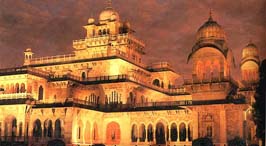
Jaipur – The Pink City, is the capital as well as the biggest city of Rajasthan. Probably the first planned city in medieval India, Jaipur was conceived, planned and built by Maharaja Sawai Jai Singh in the 18th century. The city has been planned on the basis of the Hindu concept of “Nine Divisions of the Universe”, with the streets built in a grid pattern, dotted by enthralling fortifications and other monumental structures.
One of the principal tourist attractions in Jaipur, Amber Fort is located on a hill on the outskirts of Jaipur. Built in red sandstone and white marble, by Raja Man Singh 1 and completed by Sawai Jai Singh, Amber Fort is known for its artistic style, blending both Hindu and Mughal elements. Visitors are enthralled by the scrupulous intricate works of murals and frescoes, paintings from scenes of everyday life, carvings, mosaic and detailed minute mirror work splattered all over the walls. The visitors can enjoy an elephant ride on the steep Nag pahari for reaching the Amber Fort. Jaigarh Fort and Nahargarh Fort are also located on the Aravalli hills near Jaipur. One can see the worlds biggest canyon at the Jaigarh Fort.
Known as the Palace of Winds, Hawa Mahal, is a landmark as well as an icon of Jaipur. Located in the City Palace complex, this five-storey building overlooking the busy bazaar street of Jaipur is a fascinating example of Rajput architecture and artistry with its 953 pink sandstone windows known as 'jharokhas'. It was originally built for the ladies of the royal household to watch everyday life and processions in the city from their veiled comfort.
Jal Mahal, the water palace, is located in the middle of Man Sagar lake in Jaipur. Known to be about 300 years old, it is a palace with no chambers ─ just a pavilion with a terrace garden, built in the Rajasthani tradition of ‘island resorts’ or ‘water palaces’ where royal families would seek pleasure.
The Royal Observatory or the Jantar Mantar charms the visitors with the sight of giant astronomical instruments that were designed and built under the guidance of Sawai Jai Singhji who was an astronomer. The Jaipur observatory is the largest and best preserved of the five such facilities built in India, and has been inscribed on the World Heritage List as "an expression of the astronomical skills and cosmological concepts of the court of a scholarly prince at the end of the Mughal period" Tourists can also enjoy excursions to romantic ruins and interesting tourist attractions near Jaipur, such as Sanganer, Samode, Gaitor and Tonk.
Udaipur
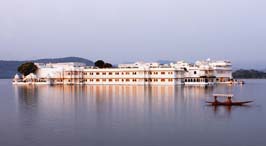
Udaipur, the “City of Lakes” is one of the most naturally beautiful cities on the planet earth, rightly called “Venice of the East”. Founded in the year 1559 by Maharana Uday Singh II, Udaipur was the capital of the earstwhile state of Mewar.
Holding the distinction of being the “Most Romantic City of India, tourists flock to this enchanting old & modern town in the heart of the Aravalli Mountains, which offers three interconnected lakes within the town - the Lake Pichhola, the Fateh Sagar Lake and the smaller Swaroop Sagar Lake; along with forts, palaces, temples, gardens, mountains and narrow lanes, reliving the reminisces of a heroic past, valor and chivalry.
City Palace, built in a flamboyant style and considered to be the largest of its type in Rajasthan, is the most impressive of a massive series of palaces on the east bank of Lake Pichola, built at different times from 1559. Lake Palace, formerly known as Jag Niwas, located on a natural foundation of 4 acres in the midst of Lake Pichola, has been converted into a luxury hotel, which has been voted as the most Romantic Hotel in India. Parts of the James Bond starrer “Octopussy” were shot here.
Other places of tourist interest in Udaipur include Jag Mandir, Sajjangarh, Sahiliyon Ki bari, besides various temples, lakes and museums. The lakes, mountains and the habitat of the city present an excellent example of harmony between the nature and the built environment. Udaipur celebrates the Mewar Festival in April every year.
Bikaner
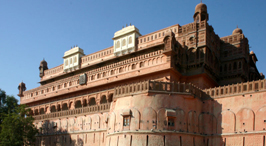
Bikaner Founded in 1488 by Rao Bika Ji, Bikaner was an important post along the great caravan routes. Imposing palaces, beautiful temples of red and yellow and the fort with its rich interior are well worth the visit. Bikaner is enclosed by an 18th Century city wall and was designed with narrow, medieval streets, with five entrance gates into the city. Attractions in Bikaner include Junagarh Fort, Lalgarh Palace, numerous old havelis and a couple of Jain temples.
Junagarh Fort is an impressive fort with 37 bastions, a moat and two entrances, and was never conquered. Within the fort there are 37 palaces, including Anup Mahal, Phool Mahal and Chandra Mahal, private temples and pavilions constructed between 1588 and 1593 by Raja Rai Singh, a general in the army for the Mughal emperor Akbar. The main entrance to Junagarh Fort is through Suraj Pol or the Sun Gate.
Lalgarh Palace, built in the early twentieth century with red sandstone, which became part hotel, part residence for Maharaja Ganga Singh. Lalgarh features several grand halls, lounges, cupolas and pavilions. A carriage from the royal train is on display in front of Lalgarh Palace.
The Bikaner Camel Festival is an event organized by the Department of Art and Culture, Government of Rajasthan, in the month of January every year . At this festival the "ships of the desert" are seen at their best. Some spectacular and unusual camel performances like camel races, camel dances, and the bumpy, neck shaking camel rides take place at this event.
Jodhpur
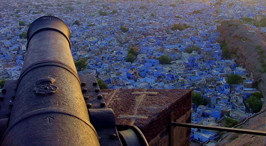
Jodhpur, founded in 1459 by Rao Jodha, is the second largest city of Rajasthan. Dominated by the huge fort, Meherangarh and surrounded by a 16th Century wall, Jodhpur is known as the Blue City due to the numerous indigo colored houses built to deflect the scorching heat of the desert, which in turn keeps the interiors cool. A long wall with eight gates fences the old city with the clock tower as a landmark.
The mammoth and imposing Mehrangarh Fort is one of the most impressive fortified palaces in Rajasthan. Built in 1459 on a towering outcrop, Mehrangarh Fort has seven gates including Jaya Pol built in 1806 by Maharaja Man Singh after his victory over Jaipur and Bikaner, and Fateh Pol, which was constructed to commemorate the defeat of the Mughals. Inside the fort is a network of courtyards and palaces including a museum that houses a splendid collection of items from the Maharajas.
Another popular tourist attraction in Jodhpur is the Mandore Garden, famous for its attractive gardens and rock terraces. The 18th Century Hall of Heroes in Mandore features Hindu deities and local heroes carved into a rock wall and then covered with plaster and painted vibrantly Umaid Bhawan Palace is another attraction of Jodhpur which is part luxury hotel and part museum. The current incumbent of the Palace is Maharaja Gaj Singh, the last ruler of Jodhpur. Besides, Jodhpur has various ancient temples, and traditional markets, where visitors can shop for Rajasthani dresses, jewellery and regalia. Jodhpur holds the Marwar Festival in October every year.
Jaisalmer
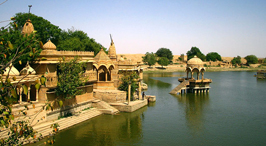
Jaisalmer, also referred to as the Golden City, presents an unforgettable heritage of the country, evoking utter magic and vibrancy of the desert. Founded by Maharawal Jaisal, it is famous for the majestic Jaisalmer Fort, the elegant Patwon Ki Haveli and the beautiful Gadisar lake. Jaisalmer Fort considered one of the oldest forts of Rajasthan was built in the 12th century by Maharawal Jaisal and presents a dazzling view at night. A visit to the famous Tazia tower, the five tiered tower coming out from the palace of the clouds, is a memorable experience for visitors.
The beautiful havelis or old mansions, which were built by wealthy merchants of Jaisalmer are yet another interesting aspect of the desert city, among which Patwon Ki Haveli, Salim Ji Ki HHaveli and Nathmal Ji Ki Haveli are the most striking ones. Gadisar Lake is one of the major tourist attractions of Jaisalmer, which is not an oasis but a water conservation tank made around 1400 A.D., which stores rainwater and supplies to the city.
Desert Festival is held in Jaisalmer over three days in January/February every year. This is the best time to visit Jaisalmer to witness performing arts like Kalbelia dances and folk songs and music. The Camel Safari from Jaisalmer is interesting and one can also see the famous Desert National Park. The hostile terrain notwithstanding, you can let your eyes caress the sloping Sand Dunes while you ramble your way in a Camel Safari.
Once a sleepy desert city, Jaisalmer has transformed itself into a major tourist destination of India. Situated amidst the picturesque Thar Desert, Jaisalmer commands a premiere position among the Indian as well as foreign tourists.



